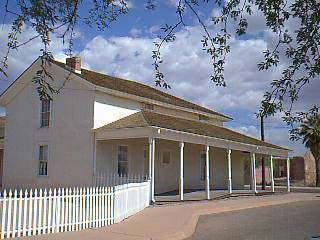
[Source: Jonathan J. Cooper, Cronkite News Service] — Late last year, crews removed scaffolding that covered the west tower of San Xavier Mission. Preservation experts had spent years removing a concrete coating, replacing disintegrating brick and restoring the original lime mortar cover.
Restoration work was supposed to move this year to the mission’s east tower, where the structure is disintegrating from the inside. But the scaffolding could stay on the ground and the tower could continue to slowly crumble now after lawmakers closing the state’s budget deficit swept millions from a fund that had committed $150,000 in lottery proceeds to the work here. “The whole thing is frustrating because you want to believe the state lives up to its word,” said Vernon Lamplot, executive director of Patronato San Xavier, a nonprofit organization created to restore the 212-year-old mission south of Tucson.
An Arizona icon dubbed “The White Dove of the Desert,” San Xavier stands a vision of contrasts. One tower is gleaming white, while the other has yellowing paint and mold. The exterior is cracked, with stucco falling from the brick walls. The restoration at San Xavier is one of about 120 projects, some already under way, that stand to lose grants from the Heritage Fund, which designates up to $20 million of state lottery revenue annually for parks, trails, historic preservation, and wildlife conservation. Voters created the fund in 1990.
There is some hope for the grants. A bill by Rep. Warde Nichols, R-Chandler, was amended to reallocate money to help prevent some state parks from closing and, among other things, replace the $4.9 million swept from the Heritage Fund. A House committee endorsed the bill, but it would require a three-quarters vote from both chambers to pass. The plan may prove unpopular because it would take the money from the Growing Smarter Fund voters created in 1998 to conserve land.
The dozens of Heritage Fund grants around Arizona are especially important now to stimulate the economy and encourage tourism, said Doris Pulsifer, grants director for Arizona State Parks, which administers much of the money. “To develop these projects provides jobs because someone has to go out there and build them,” she said. “And money is spent on the equipment and the materials.”
 Dennis Hoffman, an economics professor at Arizona State University’s W.P. Carey School of Business, said the Heritage Fund grants probably do create some jobs and have a small economic benefit. But he said it’s hard to argue that one state program is more beneficial than another as they all fight for a dwindling number of dollars. “You’ve got a million ducks fighting over two croutons,” Hoffman said. “We need more croutons. There’s just not enough money going around to fund everything that most Arizonans would agree needs to be funded.”
Dennis Hoffman, an economics professor at Arizona State University’s W.P. Carey School of Business, said the Heritage Fund grants probably do create some jobs and have a small economic benefit. But he said it’s hard to argue that one state program is more beneficial than another as they all fight for a dwindling number of dollars. “You’ve got a million ducks fighting over two croutons,” Hoffman said. “We need more croutons. There’s just not enough money going around to fund everything that most Arizonans would agree needs to be funded.”
Beth Woodin, president of the Arizona Heritage Alliance, an organization that lobbies the Legislature to continue supporting the Heritage Fund, said the sweep shows a lack of commitment to historic preservation, parks, and wildlife. “It would seem that sane and reasonable and educated people would care about the Heritage Fund,” she said. [Note: To read the full article, click here.]


